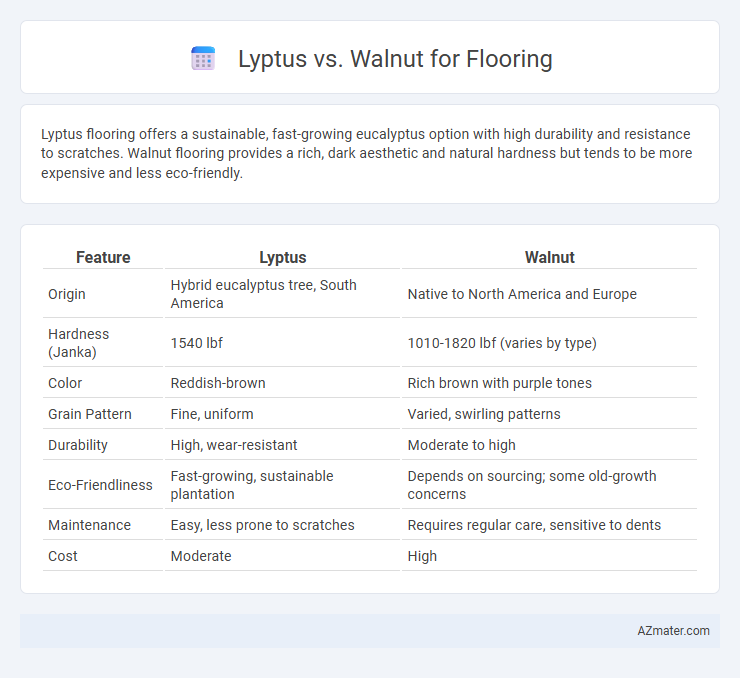Lyptus flooring offers a sustainable, fast-growing eucalyptus option with high durability and resistance to scratches. Walnut flooring provides a rich, dark aesthetic and natural hardness but tends to be more expensive and less eco-friendly.
Table of Comparison
| Feature | Lyptus | Walnut |
|---|---|---|
| Origin | Hybrid eucalyptus tree, South America | Native to North America and Europe |
| Hardness (Janka) | 1540 lbf | 1010-1820 lbf (varies by type) |
| Color | Reddish-brown | Rich brown with purple tones |
| Grain Pattern | Fine, uniform | Varied, swirling patterns |
| Durability | High, wear-resistant | Moderate to high |
| Eco-Friendliness | Fast-growing, sustainable plantation | Depends on sourcing; some old-growth concerns |
| Maintenance | Easy, less prone to scratches | Requires regular care, sensitive to dents |
| Cost | Moderate | High |
Introduction to Lyptus and Walnut Flooring
Lyptus flooring, made from a fast-growing hybrid eucalyptus tree, offers a sustainable and eco-friendly alternative with a smooth, consistent grain and a warm reddish-brown tone. Walnut flooring is prized for its rich, dark chocolate hues, natural durability, and intricate grain patterns, making it a premium choice for elegant interiors. Both options provide unique aesthetic appeal and performance characteristics, catering to diverse design preferences and flooring needs.
Key Differences Between Lyptus and Walnut
Lyptus flooring, made from a hybrid eucalyptus species, offers exceptional hardness and rapid renewability compared to traditional walnut, which is prized for its rich, dark tones and natural grain patterns. Walnut flooring tends to be softer and more susceptible to dents, making Lyptus a more durable option for high-traffic areas. While walnut provides classic warmth and elegance, Lyptus flooring features a lighter color with a more uniform texture, appealing to contemporary design preferences.
Appearance and Aesthetic Appeal
Lyptus flooring offers a consistent, uniform grain with a light to medium reddish-brown hue that brightens spaces and provides a modern, clean aesthetic. Walnut flooring stands out with its rich, deep chocolate-brown tones and distinctive swirling grain patterns, adding warmth and elegance to interiors. The choice between Lyptus and Walnut hinges on whether a sleek, contemporary look or a classic, luxurious ambiance is desired in the flooring design.
Durability and Hardness Comparison
Lyptus flooring offers exceptional durability with a Janka hardness rating around 1,520, making it highly resistant to dents and wear. Walnut, while prized for its rich aesthetic, has a lower Janka hardness of approximately 1,010, rendering it softer and more susceptible to scratches and dents under heavy foot traffic. The superior hardness of Lyptus ensures more long-lasting flooring performance compared to the softer, more delicate nature of Walnut.
Sustainability and Environmental Impact
Lyptus flooring is derived from fast-growing Eucalyptus trees planted in sustainably managed plantations, making it a renewable resource with a lower environmental footprint compared to traditional hardwoods. Walnut, while prized for its rich color and durability, typically comes from slower-growing trees that require longer harvest cycles, contributing to deforestation and higher carbon emissions. Choosing Lyptus supports responsible forestry practices and reduces habitat disruption, offering a more sustainable flooring option than walnut.
Cost and Value Considerations
Lyptus flooring offers a more budget-friendly option compared to walnut, costing approximately 30-50% less per square foot while providing a durable and sustainable hardwood choice. Walnut flooring commands a higher price due to its rich color, natural grain patterns, and premium market demand, offering increased resale value and long-term investment potential. Homeowners seeking a balance of cost-efficiency and aesthetic appeal often find Lyptus to be a smart alternative without sacrificing quality.
Installation and Maintenance Requirements
Lyptus flooring offers easier installation due to its uniform density and stability, reducing the risk of warping or splitting during the process. Walnut flooring, while aesthetically rich, may require more precise acclimation and expert handling to prevent damage, especially in varying humidity conditions. Maintenance for Lyptus involves regular cleaning and occasional refinishing but benefits from its resistance to moisture and pests, whereas Walnut needs careful upkeep with proper sealants to protect its softer wood surface from dents and scratches.
Suitable Applications for Lyptus vs Walnut
Lyptus is ideal for high-traffic areas and commercial spaces due to its hardness and resistance to wear, making it suitable for modern, sustainable flooring projects. Walnut, prized for its rich color and fine grain, excels in residential settings such as living rooms and bedrooms where aesthetic appeal and warmth are paramount. Both woods offer durability, but Lyptus performs better in environments demanding heavy use, while Walnut provides a luxurious finish for elegant interior designs.
Pros and Cons of Lyptus Flooring
Lyptus flooring offers a sustainable alternative to traditional hardwoods with its rapid growth rate and resistance to decay, making it environmentally friendly and durable. Its uniform grain and consistent color provide a modern aesthetic, but the limited availability and potential for higher cost compared to walnut can be drawbacks. Despite being harder and denser than walnut, Lyptus may show wear more quickly in high-traffic areas due to surface finish variations.
Pros and Cons of Walnut Flooring
Walnut flooring offers rich, dark tones and natural durability, making it a popular choice for luxurious and warm interior designs. Its softness compared to harder woods like Lyptus can lead to dents and scratches, but it also provides a comfortable underfoot feel and ages beautifully with a unique patina. Walnut requires regular maintenance and careful cleaning to preserve its finish and prevent damage from moisture or heavy wear.

Infographic: Lyptus vs Walnut for Flooring
 azmater.com
azmater.com